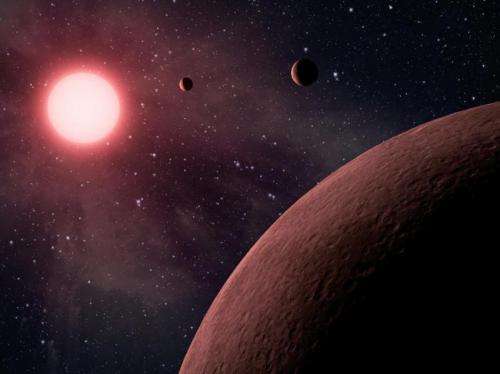January 4, 2016 report
Searching for water in the atmosphere of a Neptune-mass exoplanet HAT-P-26b

(Phys.org)—HAT-P-26b is an inflated, Neptune-mass exoplanet located about 437 light years from Earth, which orbits its parent star HAT-P-26 every 4.23 days. The planet has a relatively low surface gravity that is well suited for atmospheric characterization. However, we still know very little about the gas layer around this distant alien world. A team of astronomers led by Kevin B. Stevenson of the University of Chicago wants to change that, presenting new insights on the atmosphere of this celestial body.
In research dedicated to determining the composition of HAT-P-26b's atmosphere and finding traces of water vapor in it, the scientists made use of data provided by the Low Dispersion Survey Spectrograph 3C (LDSS-3C) instrument and NASA's Spitzer Space Telescope. LDSS-3C is an optical imager and (multi-) slit spectrograph on the 6.5m Magellan II (Clay) telescope at Las Campanas Observatory in Chile. The results, based on LDSS-3C and Spitzer data, were published on Dec. 24 in the arXiv pre-print server.
The researchers observed the primary transit of HAT-P-26b with LDSS-3C on Apr. 16, 2015 for nearly five hours, using the multi-object technique developed to probe exoplanet atmospheres. They acquired 502 science frames using 20 second integrations. Thanks to Spitzer, the scientists were able to observe two transits of the planet in April and September 2013. The science observations using NASA's spacecraft lasted approximately 4.5 hours and acquired 8,128 frames, utilizing two-second frame times. To place the results into a broader context, HAT-P-26b was compared to other exoplanets with similar temperatures and surface gravities like HAT-P-12b and HAT-P-19b.
Stevenson and his colleagues have found the evidence of water and lack of potassium in HAT-P-26b's atmosphere. They also found out that the planet's gas layer could be cloud-free with a high-metallicity. However, it could also have a solar metallicity atmosphere, according to the research.
"Targeting the Neptune-mass planet HAT-P-26b, we find tentative evidence for water and a lack of potassium in its transmission spectrum. (…) We conclude that HAT-P-26b is likely to have a high-metallicity, cloud-free atmosphere or a solar metallicity atmosphere with cloud deck at about 10 mbar. Although more high-precision data are needed to break this degeneracy, a 100 times solar-metallicity atmosphere is consistent with expectations based on Uranus and Neptune's similar metallicities. Alternatively, since HATP-26b has a similar equilibrium temperature and surface gravity to that of HAT-P-12b, it is conceivable that the smaller HAT-P-26b simply has lower altitude clouds and, thus, a metallicity that is closer to solar," the researchers wrote in the paper.
The scientists note that understanding the prevalence of clouds and hazes is one of the major outstanding issues in exoplanetary atmospheres. Temperature and surface gravity are thought to play a significant role in the production of clouds and hazes, but much work is needed to fully understand this mechanism.
"To advance our knowledge, we need to obtain precise transmission spectra of targets that have a variety of physical characteristics and continue investigating potential correlations," the paper reads.
In addition to characterizing HAT-P-26b's atmosphere, the research also updated the planet's transit ephemeris and orbital period.
The astronomers believe that pending Hubble Space Telescope observations and future studies of HAT-P-26b will provide the necessary precision to make a definitive detection and potentially distinguish between a high-metallicity or a solar-metallicity atmosphere. They recommend performing follow-up observations of this curious exoplanet using one or more instruments at overlapping wavelengths.
More information: A Search for Water in the Atmosphere of HAT-P-26b Using LDSS-3C, arXiv:1511.08226 [astro-ph.EP] arxiv.org/abs/1511.08226
Abstract
The characterization of a physically-diverse set of transiting exoplanets is an important and necessary step towards establishing the physical properties linked to the production of obscuring clouds or hazes. It is those planets with identifiable spectroscopic features that can most effectively enhance our understanding of atmospheric chemistry and metallicity. The newly-commissioned LDSS-3C instrument on Magellan provides enhanced sensitivity and suppressed fringing in the red optical, thus advancing the search for the spectroscopic signature of water in exoplanetary atmospheres from the ground. Using data acquired by LDSS-3C and the Spitzer Space Telescope, we search for evidence of water vapor in the transmission spectrum of the Neptune-mass planet HAT-P-26b. Our measured spectrum is best explained by the presence of water vapor, a lack of potassium, and either a high-metallicity, cloud-free atmosphere or a solar-metallicity atmosphere with a cloud deck at ~10 mbar. The emergence of multi-scale-height spectral features in our data suggests that future observations at higher precision could break this degeneracy and reveal the planet's atmospheric chemical abundances. We also update HAT-P-26b's transit ephemeris, t_0 = 2455304.65218(25) BJD_TDB, and orbital period, p = 4.2345023(7) days.
© 2016 Phys.org



















